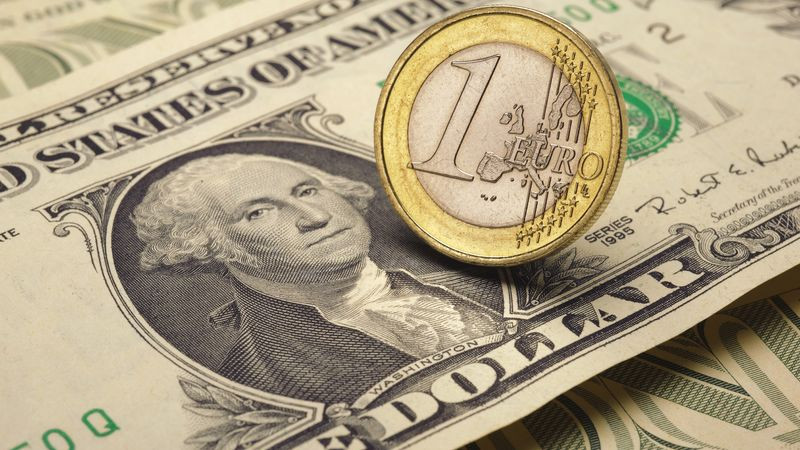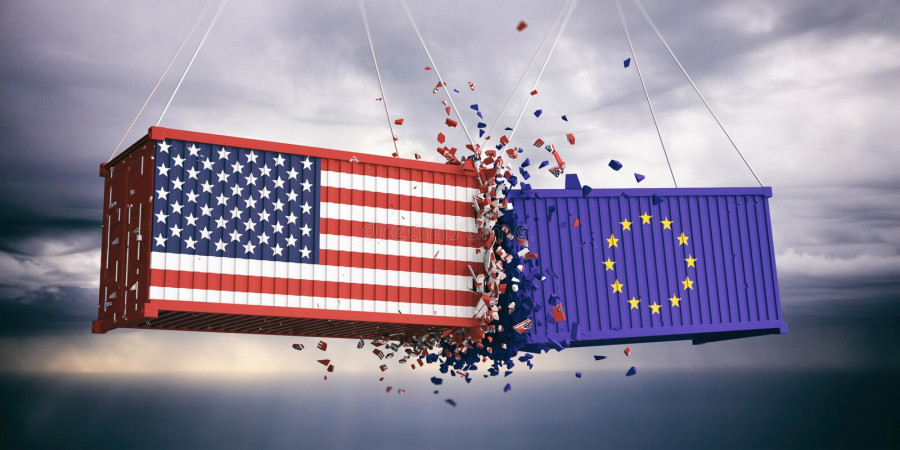

If someone had said at the beginning of the year that the euro would trade below parity with the dollar, many would have taken it as a joke. At that time, most experts and traders were betting on the weakening of the US currency, believing that the hawkish expectations from the Federal Reserve have largely already been taken into account in the USD rate, as well as the lion's share of bad news.
In the first two months of the year, the greenback really showed uncertain dynamics, only fueling the opinion that the best times for it were behind.
Back in February, the single currency was trading around $1.15 amid talk that the post-pandemic euphoria of spending, combined with abundant government support, should stimulate the regional economy.
But all this changed when Europe found itself at the forefront of the military conflict between Russia and Ukraine.
The dollar has returned to an upward trajectory, benefiting from capital flows to safe havens, as well as the belligerent attitude of the Fed, which raised interest rates at the fastest pace since the 1980s.
Meanwhile, the euro came under selling pressure, having gone into a steep peak. The single currency suffered due to the deterioration of the prospects for the growth of the regional economy and the increase in the cost of energy imports, as well as due to the slowness of the European Central Bank to raise interest rates.
The increase in the rate difference between the Fed and the ECB prompted investors to switch to the dollar and abandon the euro in search of greater profitability.
In addition, the American economy, compared to the European one, was better protected from the supply shock in the gas market due to less dependence on external energy supplies. High demand for LNG, which the United States exports to Europe, has reduced pressure on the dollar through the trade balance and added trump cards to the US currency.
At the same time, the euro has lost fundamental support from trade factors. In 2022, the EU's trade balance turned negative due to the rise in gas prices. This has dealt a blow to the competitive positions of the region.

However, even when the decline of the EUR/USD pair began to gain momentum, fans of the single currency hoped that 1.0500, 1.0300 and 1.0200 were not the levels that would give up so easily.
However, a historic event still occurred on July 14, when one euro was bought for $0.9952.
Parity has been at the heart of Wall Street forecasts for many years, but until now it seemed unattainable.
Why did the euro fall below $1 in mid-July?
This happened for a number of reasons.
Firstly, on July 11, the pipeline, which accounts for more than a third of Russian natural gas exports to the EU, was stopped for ten days of annual maintenance. This has raised fears that Russia will introduce a full-scale gas shutdown, which will lead the European region into a deep recession.
Secondly, the data released on July 13 showed that inflation in the United States grew at the fastest pace in four decades. As a result, traders began to win back the prospect of a Fed rate hike by 100 basis points.
In addition, on July 14, Italian Prime Minister Mario Draghi announced that he had decided to resign. The collapse of the ruling coalition in the country has given rise to fears that if the political situation becomes more complicated and the new government is unable to coordinate further actions with the European Commission, the result will be so-called "fragmentation" and a new debt crisis.
Finally, on July 15, China reported that national GDP in the second quarter slowed down more than expected. This caused concern for the fate of the global economy.
Then the fall of the euro below parity with the dollar turned out to be fleeting and was quickly redeemed.
The single currency lasted a little more than a month above the $1 mark.
By August 12, the EUR/USD pair managed to recover more than 4% from multi-year lows. The six-week rally of the euro fizzled out around $1.0370, after which it moved to a decline and on August 22 it was again quoted less than one dollar.
According to experts, the main currency pair's fall below parity this week indicates the scale of the problems facing the currency bloc.
A year ago, most economists predicted a 5% rise in eurozone GDP in 2022. Now the winter recession becomes the base scenario.
Households and businesses are suffering as the consequences of the military conflict in Ukraine – high food and energy prices – are currently being exacerbated by a devastating drought and low river levels, which have reduced the supply of key goods by water.
"The biggest problem in Europe is energy. This leaves the dollar at a high level and puts pressure on the euro," Neuberger Berman analysts noted.
The recent fall in the euro was provoked by news about the complete shutdown of gas pumping to the EU via the Nord Stream-1 pipeline for a three-day period from August 31 due to the need for maintenance.
Gazprom's decision to stop supplies was made amid the hype in the gas market, as European countries are trying to fill their storage facilities before winter.
As a result, the cost of blue fuel in the eurozone exceeded $3,000 per thousand cubic meters for the first time since the beginning of March.
"The gas shock is much stronger today; it is almost twice the shock that we experienced in the 1970s with oil. Over the past two years, we have seen a 10-11-fold increase in spot prices for natural gas in Europe," analysts at Capital Economics said.
The EU recently unveiled plans to accelerate the transition to renewable energy sources and abandon Russian gas by 2027. This will make the bloc more stable in the long run.
But energy independence has its price.
For ordinary people, this will mean colder homes and offices in the short term, as a shortage of supplies forces the EU to seek a 15% reduction in gas consumption this year.
For businesses, this will mean a decrease in production volumes, which will further slow down economic growth.
Energy-intensive industries are already suffering.
Almost half of Europe's aluminum and zinc smelting capacity has already been shut down, while most of the fertilizer production, which depends on natural gas, has been shut down.
That's why many, if not most economists, believe that Germany and Italy, the number one and number four economies in Europe, heavily dependent on Russian gas, will soon enter a recession.
"American households are having a hard time paying their utility bills. Nevertheless, this situation pales in comparison with the price increases faced by European consumers," Rabobank strategists noted.
JPMorgan analysts, in turn, point to encouraging recent data from the United States on inflation and employment compared to the growing vulnerability in the EU as a key reason for the weakness of the euro.
The US consumer price index rose by 8.5% year-on-year in July, down from 9.1% in June. At the same time, an unexpected acceleration in the number of jobs in the country in July reduced fears that the national economy is in recession.
Meanwhile, inflation in Europe is approaching double-digit values, which is largely due to the ongoing Russian-Ukrainian conflict and the resulting energy crisis.
Experts warn that the eurozone may fall into a spiral of wage and price growth, which is why investors are reluctant to buy the euro even after its sharp drawdown.
The EUR/USD pair stabilized, touching new 20-year lows around 0.9900 on Tuesday, August 23. However, according to a number of analysts, the potential for further decline remains.
Natixis strategists believe that the euro is only slightly weakened compared to what levels it could be at.
"Currently, the euro is weak due to a number of factors: lower actual and expected interest rates compared to the United States, problems with energy supply in Europe, the disappearance of the positive trade balance of the eurozone. We believe that the euro is only slightly weak and that it may be much weaker, in particular, if the net open position on EUR becomes negative, or if non-residents sell their euro-denominated shares," they said.
It will still be difficult for the EUR/USD pair to break above 1.00, analysts at Brown Brothers Harriman say. They believe that the pair remains on track to test the September 2002 low near 0.9615.
"The minutes from the July ECB meeting deserve discussion. The bottom line is that the central bank will continue to raise rates and just hope that the market will not be determined to keep peripheral spreads at a lower level. This is a dangerous position as the September elections in Italy approach, given the unwillingness of creditor countries to unconditionally support debtors," they said.
According to polls, a month before the elections in Italy, the right alliance enjoys the support of almost 50% of voters.
The data show that the Brothers of Italy party is leading in the right-wing bloc, gaining 24% of the vote, ahead of the center-left Democratic Party with 22.6%.
The prospect of the victory of the alliance of the right in the early elections in Italy on September 25 does not please the single currency at all. This alliance, presumably, will challenge the EU on the issue of the budget deficit limit.
Nordea economists expect the EUR/USD pair to drop to 0.9700 by the end of 2022.
"We expect an even greater decline in the pair and are still aiming for the level of 0.9700 by the end of the year. A recession in the eurozone and especially in Germany looks increasingly likely this winter," they said.
Nomura strategists give a forecast for EUR/USD, which provides for a steady break below parity in the coming months.
"Isn't all the bad news already included in the price? We would strongly state that this is not the case. The EUR/USD pair is likely to fall to 0.9000 this winter, and the shock from the trading conditions indicates a possible level of 0.6500," they noted.
"Isn't 0.6500 too much? Perhaps, yes, if the terms of trade in Europe eventually improve with lower energy prices. But if prices remain extreme during this winter and next, it will become much more difficult for the euro to rise above parity with the dollar," Nomura added.